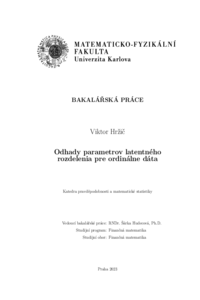Odhady parametrov latentného rozdelenia pre ordinálne dáta
Estimation of latent distribution for ordinal data
Odhady parametrů latentního rozdělení pro ordinální data
bachelor thesis (DEFENDED)

View/
Permanent link
http://hdl.handle.net/20.500.11956/184590Identifiers
Study Information System: 249987
Collections
- Kvalifikační práce [11330]
Author
Advisor
Referee
Komárek, Arnošt
Faculty / Institute
Faculty of Mathematics and Physics
Discipline
Financial Mathematics
Department
Department of Probability and Mathematical Statistics
Date of defense
8. 9. 2023
Publisher
Univerzita Karlova, Matematicko-fyzikální fakultaLanguage
Slovak
Grade
Very good
Keywords (Czech)
odhady parametrov|parametrické modely|metóda maximálnej vierohodnosti|ordinálne dáta|latentné rozdelenieKeywords (English)
estimation of parameters|parametric models|maximum likelihood estimation|ordinal data|latent distributionHlavným cieľom práce je predstavenie problematiky ordinálnych dát a najmä následne vytvorených odhadov latentného rozdelenia hustoty. Takto získané odhady sú porovná- vané v simulačnej štúdii s inými metódami tvorby odhadov, ktoré sú v praxi používané častejšie. Čitateľ bude oboznámený s metódou maximálnej vierohodnosti, ktorá bola vy- užitá pri tvorbe jednotlivých odhadov. Jedna časť je venovaná aj alternatívnemu prístupu využitím Bernsteinových polynómov. Bolo zistené, že s prihliadnutím na benefity, kto- rými sú bezpochyby jednoduchší zber dát v ordinalizovanej podobe a minimalizácia chýb ktorých sa môže dopustiť respondent, sme dostali veľmi kvalitné a hodnotné výsledky. 1
The main goal of the bachelor thesis is to introduce problematics of ordinal data together with estimations of latent density distribution based on ordinal data. The esti- mations obtained using ordinal data are compared to the ones that are more common and used on daily basis. The reader will be introduced to the maximum likelihood method that is used in the development of each estimate. One chapter is dedicated to alterna- tive approach using Bernstein polynomials. When we take all benefits into account such as easier collecting the data in ordinal form or minimization of possible errors committed by respondent, we obtained very valuable and promising results. 1
